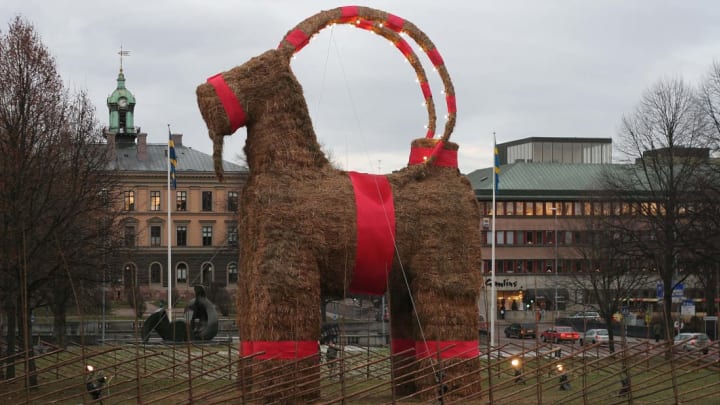The Fiery History of Scandinavia's Yule Goat
By Mark Mancini

In Gävle, Sweden, nothing says “Christmas” like the sight of a four-ton straw goat overlooking the town square. Too bad some jerk usually comes along and lights it on fire.
The first Gävle Goat was put up on December 1, 1966. Financed by a local entrepreneur, the magnificent beast stood 23 feet in length and over four stories tall. But this colossus of holiday cheer went up in smoke that New Year’s Eve at the hands of a nearby pyromaniac. Luckily, the goat was insured and the perpetrator was charged with vandalism. Since then, a new model is built from hay (almost) every year in a tradition that ranks among the country’s most famous.
Unfortunately—as the good people of Gävle know all too well—no goat is hooligan-proof. In 2012, it only took until December 12th for that year's specimen to be burned to a crisp.
But petty arson is hardly the worst fate that can befall a Gävle goat. Other grisly demises include getting kicked to pieces and being hit by a car. In 2010, a pair of schemers planned to kidnap the goat and transport it to Stockholm via helicopter, only to have the guard on duty reject their bribe of 50,000 kronor (about $7350).
Fed up with these malicious acts of violence against fake livestock, in 2013 officials announced that the straw used in that year's incarnation had been treated with fire-proof liquids.
This strange Gävle custom was inspired by the yule goat of Scandinavian lore. Horned herbivores have enjoyed a rich history in the region’s culture and mythology; even the mighty god Thor himself was said to have ridden in a cart pulled by a pair of goats named Tanngniost and Tanngrisnir, who could be killed and devoured before coming back to life the following morning.
This may have inspired the subsequent mid-winter Norwegian custom of Julebukking (“yule-goating”), which involved going door to door dressed like goats while singing carols in pursuit of snacks and alcohol. Modern children have since revived this pre-Christian practice, albeit with slight alterations.
Today, yule goat figurines are a commonly-used Christmas ornament constructed from straw, with braided horns and red ribbons wrapped around their necks. Generally placed under the tree, these can also be mischievously hidden in the house of a friend or neighbor, with the understanding that it’s now their turn to go and plant it in somebody else’s home. For more information on this remarkable piece of Scandinavian heritage, head here.